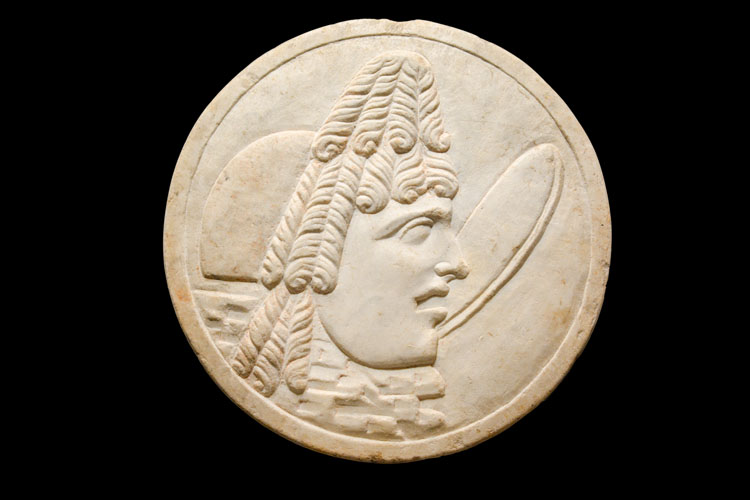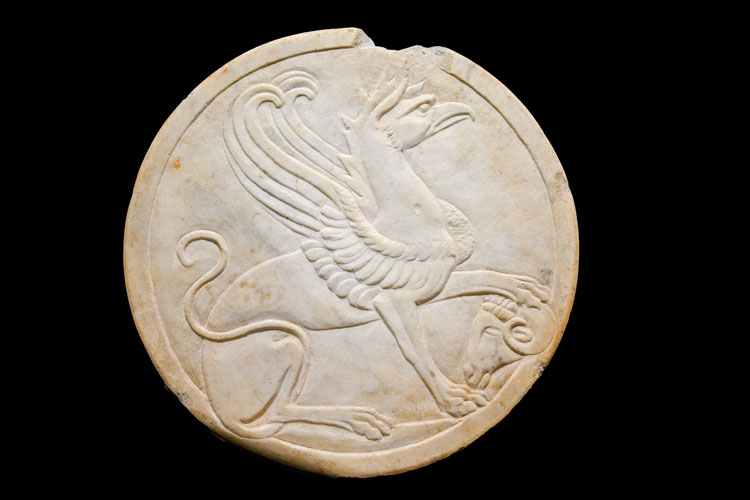Oscillum
Category
Gozo GroupAbout This Artefact
I.D. no: 100897
Dimensions: D. 28 cm; max. Th. 2.5 cm (incl. relief: 3 cm)
Material: Fine-grain white marble
Provenance: Unspecified; reputedly from Gozo.[1]
Current location: Museum of Archaeology, Gozo
Condition: On one side the marble survives intact. No pierced holes for hanging are visible, but a chip affecting only the top of the griffin side reveals a cylindrical hole drilled vertically into the rim. Traces of a reddish colour are detectable in the hair of the mask.
Description: This sculptured piece is an oscillum and consists of a disk-shaped marble decorated with scenes carved in very low relief on both sides, within a narrow plain border along the whole circumference.[2]
Side A displays a theatrical mask with high-piled hair (ὄγκοϛ), open mouth and hard facial features, resting on a rocky outcrop. An elliptical object, lightly incised on the plane background in front of the mask, probably represents a mirror.
Side B shows, in a noticeably higher relief on a neutral background, a squatting griffin having an eagle head, sphinx’s wings and feline body and paws. Its left paw rests on a ram’s head in profile facing left with closed eye.
Discussion: As already noted the relief is considerably higher on one side than on the other, which seems to be an inherent characteristic of the decorative function of these oscilla that were suspended in the air between columns in the peristyle of the wealthier Roman houses, one side facing the outer, brighter side of the colonnade, the other facing the inner, darker side.[3] This function is confirmed by the discovery in situ of similar oscilla in Pompeii, especially in the House of the Golden Cupids.[4]
Very similar in style and subject matter is an oscillum in the reserve collection of the Vatican showing a female tragic mask and a satyric one on one face and a hippocamp on the other.[5] Closer still is an oscillum from Bolsena which shows an identical female mask, with a similar round object in front of it but different hair-do and closed lips on the main side, and another hippocamp, whose head is almost identical to that of our griffin, on the opposite side.[6] The representation on the principal side, however, has an identical parallel in the rectangular oscillum in the former Museo Nuovo of the Conservatori, showing a similar mask resting on a rocky mound.[7] As to the secondary side, one should remember that representations of griffins in a similar posture are not rare in Roman relief sculpture,[8] though as yet not on oscilla.
So far as the execution of the carving is concerned, it can be said that, though lacking in plasticism, the relief is worked with some attention to decorative details (such as in the hair of the mask and the wings of the griffin) while one notes a certain rapidity of execution in the hard face of the mask and the schematic rendering of the rocks.
Date: It seems that oscilla came into fashion in the Roman west in the first century AD and lost their popularity in the second half of the second century AD. Comparison with several oscilla from Pompeii[9] and Cosa[10] helps to assign the Maltese specimen to the first century AD.
Bibliography: (previous publications of item):
Della Torre di Rezzonico 1794 (‘found in Gozo and kept in the Valletta Bibliotheca’). Denon 1802: 10, 226, pl. 4, figs 5 and 7 (‘Antiquités trouvées au Gose’). Boisgelin 1804: 8-9, pl. 1, fig. 4 (‘in the marquis Barbaro’s cabinet of curiosities’). Caruana 1882:114. Ashby 1915: 76 (‘found in Gozo: see Caruana, p. 77; Zammit, 41; museum no. 52’); Zammit 1919: 26 repeats Ashby verbatim. Bonanno 1971: 219-23. Eynaud 1989: 58-59. Bonanno 1992: 33, pls 43-44. Bonanno 2005: 148. Buhagiar 2018.
[1] For a recent account of the earliest mention of this oscillum, see Buhagiar 2018.
[2] For an updated and comprehensive assessment of this type of artifact, with a conveniently classified bibliography, see R. Taylor , Roman oscilla: an assessment, Res: Anthropology and aesthetics 48, (Autumn 2005): 83-105. See also A. Bacchetta, Oscilla. Rilievi sospesi di età romana, Milan, Università degli Studi di Milano, 2006.
[3] See G.A. Mansuelli, s.v. Oscilla in Enciclopedia dell’Arte Antica, vol. 5 (1963): 780-81 (with previous bibliography); J.M. Pailler, À propos d’un nouvel oscillum de Bolsena, Mélanges de l’Ècole Française de Rome
81 (1969) 627-58.
[4] A. Sogliano, Casa degli Amorini Dorati, Notizie Scavi 1907 4: 549-93, figs 33-36.
[5] Kaschnitz-Weinberg 1936-37: 197, no. 439, pl. 78.
[6] Pailler 1969: note 3, figs 2-3.
[7] Mustilli 1938: Sala III, no. 148, pl. 36.
[8] See Jones 1912: 261-62, nos 101, 103, pl. 63. A griffin of the same type, but in bronze and in the round, comes from Helenenberg (G. Picottini, CSIR Österreich II, 1, Die Rundskulpturen des Stadtgebietes von Virunum, Vienna, Böhlau in Komm, 1968: no. 59, pl. 42).
[9] F.G. Welcker, Alte Denkmäler, vol. 2, Göttingen, Dieterich, 1850: 122-45.
[10] J.L. Collins, The Marble Sculptures from Cosa, Ann Arbor, University Microfilms International, 1982: 29-90.


